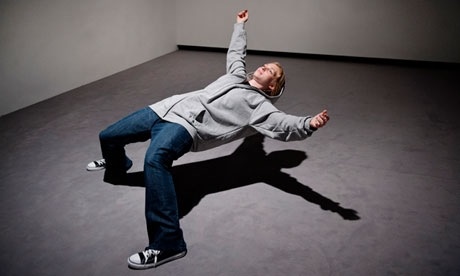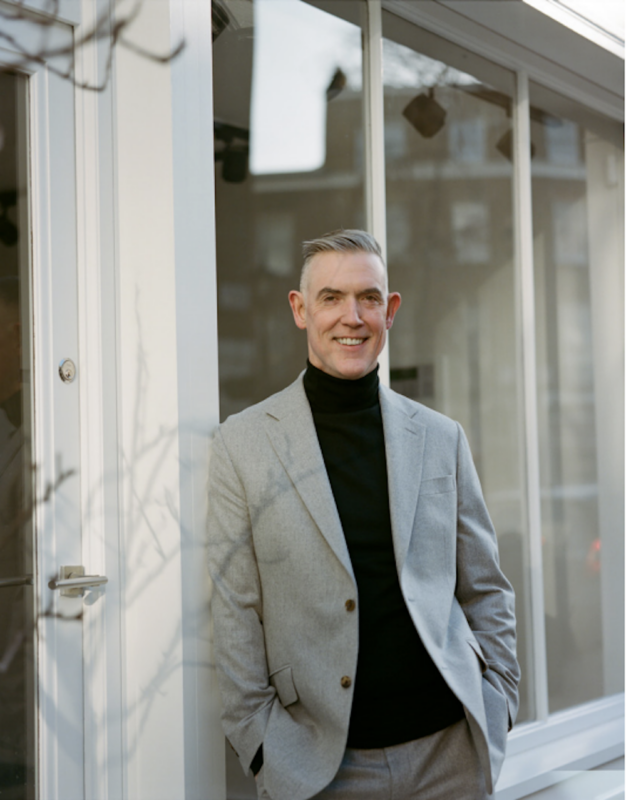
Xu Zhen’s extraordinary In Just a Blink of an Eye, 2005: ‘One suddenly comes to understand that this falling figure is not a statue at all but a living being.’ Photograph: Linda Nylind
You have to bend low to pass through the little door. On the other side it is mysteriously twilight. A glade of trees casts stark shadows in the dusk and among them stands a Chinese woman quietly humming to herself, and to you. For she seems to have been awaiting your arrival.
Gradually this woman begins to walk towards you, dry leaves rustling beneath her bare feet. Her eyes catch yours and you can’t look away. The effect is transfixing – the approach, the melodic humming, the building suspense, for what will she do when she reaches you (and what will you do, come to that)? I broke into a smile, she smiled too, but who was leading whom? Face to face, eye to eye, so near and yet so far: it felt as if we were spellbound.
I have never experienced an encounter quite like it in a gallery: an encounter that so completely exposed the gulf between two strangers, but also between two foreigners. For how would a Chinese visitor have responded? Should one laugh, speak, embrace this woman with her charismatic smile and her pockets full of handwritten notes? The performance puts you on the spot, irresistibly bringing such questions to mind.
Yingmei Duan is a considerable presence in contemporary Chinese art. She was born in 1969 in the northeastern oil fields and endured the local stigma of a cleft palate until she was an adult. Hers is an art that courts speech without actually speaking, and its eloquence relies upon this poignant muteness. At the Hayward Gallery she is also responsible for the flitting figures in striped pyjamas that hover behind one’s shoulder, silently shadowing every move.
At the outset, these girls seemed political – what else? – with their unnerving scrutiny, breathing down one’s neck. I tried in vain to catch mine out by turning very fast, desperate to shake her off. But gradually the pendulum swung and it felt as if she herself was in some sense anxious or afraid. I decided to talk to her, this elusive somnambulist, but by then she had somehow vanished.
Almost every work in Art of Change has the force of an encounter. You come upon gigantic beetles and a hyperreal triceratops, the size of life, ogling you with its beady eyes. You come across silkworms working at their subtle task, cocooning objects with their silvery-white floss. There are games of ping-pong played on weirdly distorted tables and chairs that double as drums. Many of the exhibits are living people.
Nine artists are represented with work from the past 30 years. There are installations, videos and many live performances. But if that sounds just like any other Hayward show, be aware that this one feels about as remote from the familiarity of European art as it gets.
Indeed, it feels fairly remote, too, from the contemporary Chinese art that has so glutted the market of late that industry insiders regularly talk of burn-out. China was the hit of the Venice Biennale as far back as 1999. Charles Saatchi opened his Chelsea gallery with a Chinese show in 2008. Chinese collectors, riding high on the economic miracle, bought so much political pop and cynical realism that some Chinese artists were millionaires a decade ago.
What makes this show exceptional is that it looks at the art hidden behind all that success; in some cases literally made, or shown, under the ground. There are videos of performances that lasted a day or two before they were closed by the authorities, and work by artists whose shows never opened at all. The art is uniformly strong.
But it is also opaque at times. Those Beijing gallery-goers herded into a cage and menaced by a Chinese tiger: does this translate as satirically as one imagines? Those dogs tethered to running machines that rush nowhere on all fours: is this a verbal-visual play on the communist insult “running dog”? And what about the Madein Company, with its political art and its English pun of a title, does that mean exactly the same thing there as it does in London?
The opening gallery is a cemetery of tombstones, or rather tombs to stones thrown during protests in China. A woman sits there making grey casts of these political relics; a sign urges you to bring in some of your own. But from where exactly? Some forms of art simply cannot mean the same thing in Britain as they might in China.
Much of the work is disorienting – the maze that turns out to have no entrance, but from which random objects are thrown high in the air (or are they so random?). Madein Company’s video of an African child being manipulated through Chinese religious rituals in what looks like a zoo, while a vulture sits by, is unbearably upsetting as it seems to put one in the position of a news photographer in a war zone. It means far more if one knows something about China’s political relationship, for instance, with Sudan.
At one point visitors encounter the proverbial China condensed in one gallery – tea houses, paddy fields, rosewood furniture. But every cliche is utterly disrupted. The ping-pong table does not function, nobody is drinking tea, and the crops have been genetically modified (by the artist) to exceed all quotas.
There is a moment where you suddenly feel you’re on familiar ground with the arte povera work of Chen Zhen, his temples, boats and tea houses made of household candles, his mud-coated room in which every single thing from the bicycle to the rice bowl is caked in the stuff, a monochrome shrine to the everyday. But Zhen, who died in 2000, had emigrated to Paris, and there is a strong flavour of the west in his work.
But what is most enthralling here is also most strange: the warm, dark gallery in which it is possible not only to see but also to hear silkworms, greatly magnified, eating their way through crisp leaves and apparently coughing very quietly every now and again; a beautiful and meditative piece, but also ineffably comic.
Or Xu Zhen’s extraordinary falling figure: a woman suspended in freeze-frame on the way down from a great height, arms flailing, with no visible means of support. She has fallen in the blink of an eye, and with the blink of an eye – her own – one suddenly comes to understand that this is not a statue at all but a living being. I have no idea how this is achieved, for there are no wires, and no obvious armature for her falling body. But the effect is singularly dramatic.
One feels as protective towards her as one felt warmly towards the woman in her enchanted forest. These are unfamiliar feelings for an art gallery, to say the least, but this is a most uncommon show of art.
guardian.co.uk © Guardian News & Media Limited 2010
Published via the Guardian News Feed plugin for WordPress.









